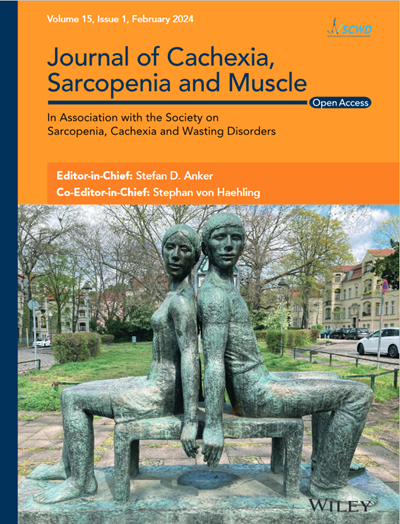Skeletal muscle analysis of cancer patients reveals a potential role for carnosine in muscle wasting
Abstract
Background
Muscle wasting during cancer cachexia is mediated by protein degradation via autophagy and ubiquitin-linked proteolysis. These processes are sensitive to changes in intracellular pH ([pH]i) and reactive oxygen species, which in skeletal muscle are partly regulated by histidyl dipeptides, such as carnosine. These dipeptides, synthesized by the enzyme carnosine synthase (CARNS), remove lipid peroxidation-derived aldehydes, and buffer [pH]i. Nevertheless, their role in muscle wasting has not been studied.
Methods
Histidyl dipeptides in the rectus abdominis (RA) muscle and red blood cells (RBCs) of male and female controls (n = 37), weight stable (WS: n = 35), and weight losing (WL; n = 30) upper gastrointestinal cancer (UGIC) patients, were profiled by LC–MS/MS. Expression of enzymes and amino acid transporters, involved in carnosine homeostasis, was measured by Western blotting and RT-PCR. Skeletal muscle myotubes were treated with Lewis lung carcinoma conditioned medium (LLC CM), and β-alanine to study the effects of enhancing carnosine production on muscle wasting.
Results
Carnosine was the predominant dipeptide present in the RA muscle. In controls, carnosine levels were higher in men (7.87 ± 1.98 nmol/mg tissue) compared with women (4.73 ± 1.26 nmol/mg tissue; P = 0.002). In men, carnosine was significantly reduced in both the WS (5.92 ± 2.04 nmol/mg tissue, P = 0.009) and WL (6.15 ± 1.90 nmol/mg tissue; P = 0.030) UGIC patients, compared with controls. In women, carnosine was decreased in the WL UGIC (3.42 ± 1.33 nmol/mg tissue; P = 0.050), compared with WS UGIC patients (4.58 ± 1.57 nmol/mg tissue), and controls (P = 0.025). Carnosine was significantly reduced in the combined WL UGIC patients (5.12 ± 2.15 nmol/mg tissue) compared with controls (6.21 ± 2.24 nmol/mg tissue; P = 0.045). Carnosine was also significantly reduced in the RBCs of WL UGIC patients (0.32 ± 0.24 pmol/mg protein), compared with controls (0.49 ± 0.31 pmol/mg protein, P = 0.037) and WS UGIC patients (0.51 ± 0.40 pmol/mg protein, P = 0.042). Depletion of carnosine diminished the aldehyde-removing ability in the muscle of WL UGIC patients. Carnosine levels were positively associated with decreases in skeletal muscle index in the WL UGIC patients. CARNS expression was decreased in the muscle of WL UGIC patients and myotubes treated with LLC-CM. Treatment with β-alanine, a carnosine precursor, enhanced endogenous carnosine production and decreased ubiquitin-linked protein degradation in LLC-CM treated myotubes.
Conclusions
Depletion of carnosine could contribute to muscle wasting in cancer patients by lowering the aldehyde quenching abilities. Synthesis of carnosine by CARNS in myotubes is particularly affected by tumour derived factors and could contribute to carnosine depletion in WL UGIC patients. Increasing carnosine in skeletal muscle may be an effective therapeutic intervention to prevent muscle wasting in cancer patients.

 求助内容:
求助内容: 应助结果提醒方式:
应助结果提醒方式:


